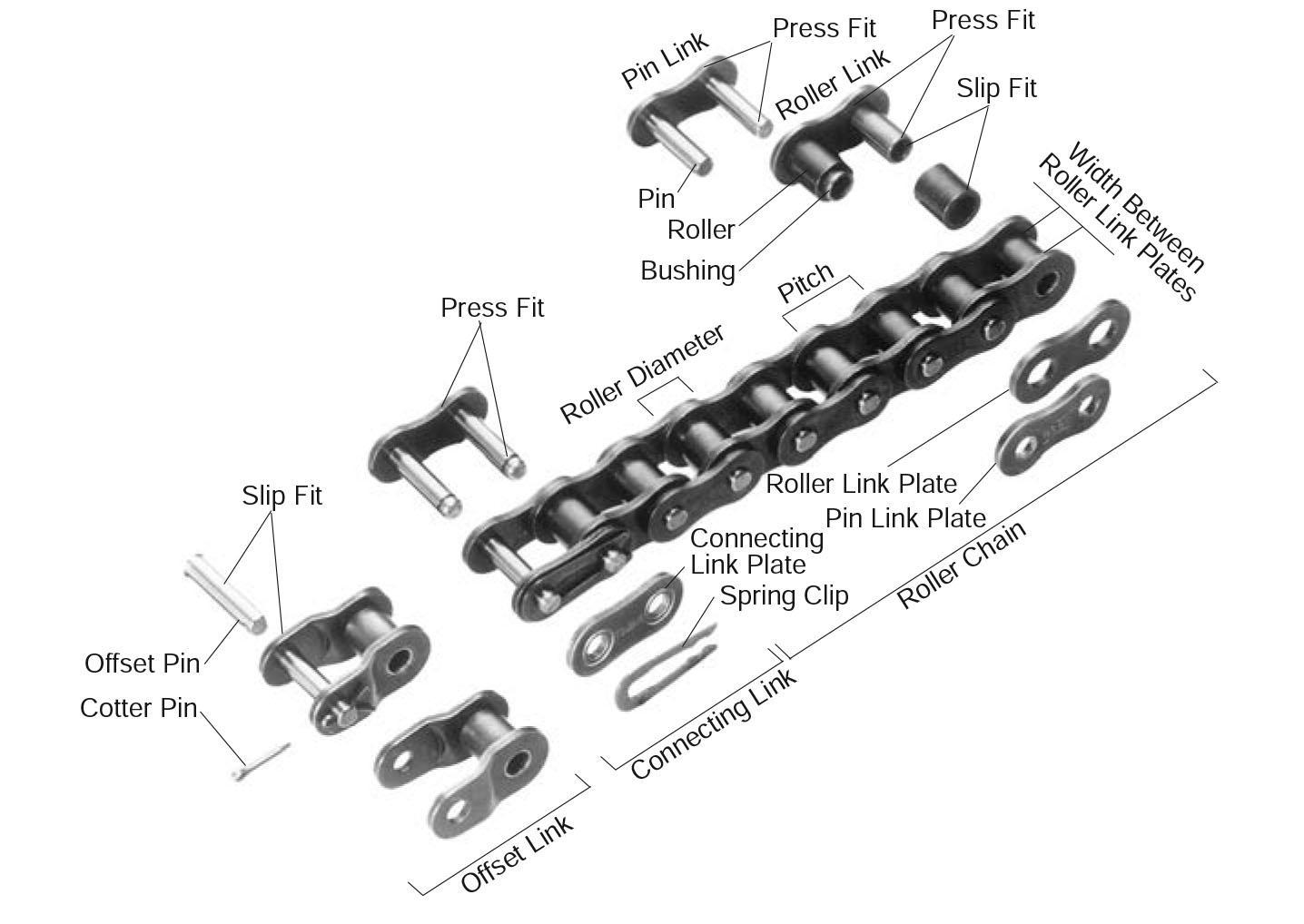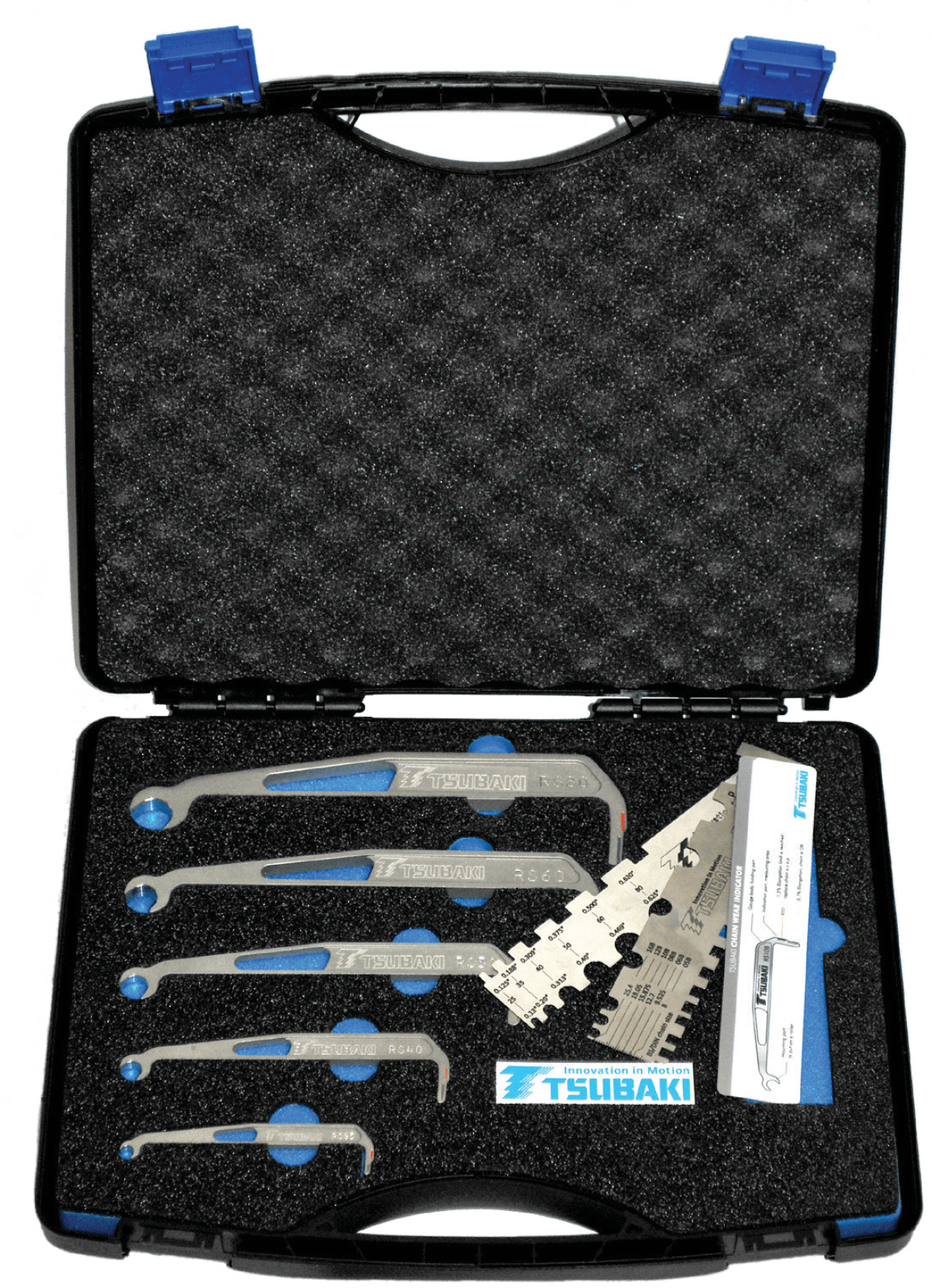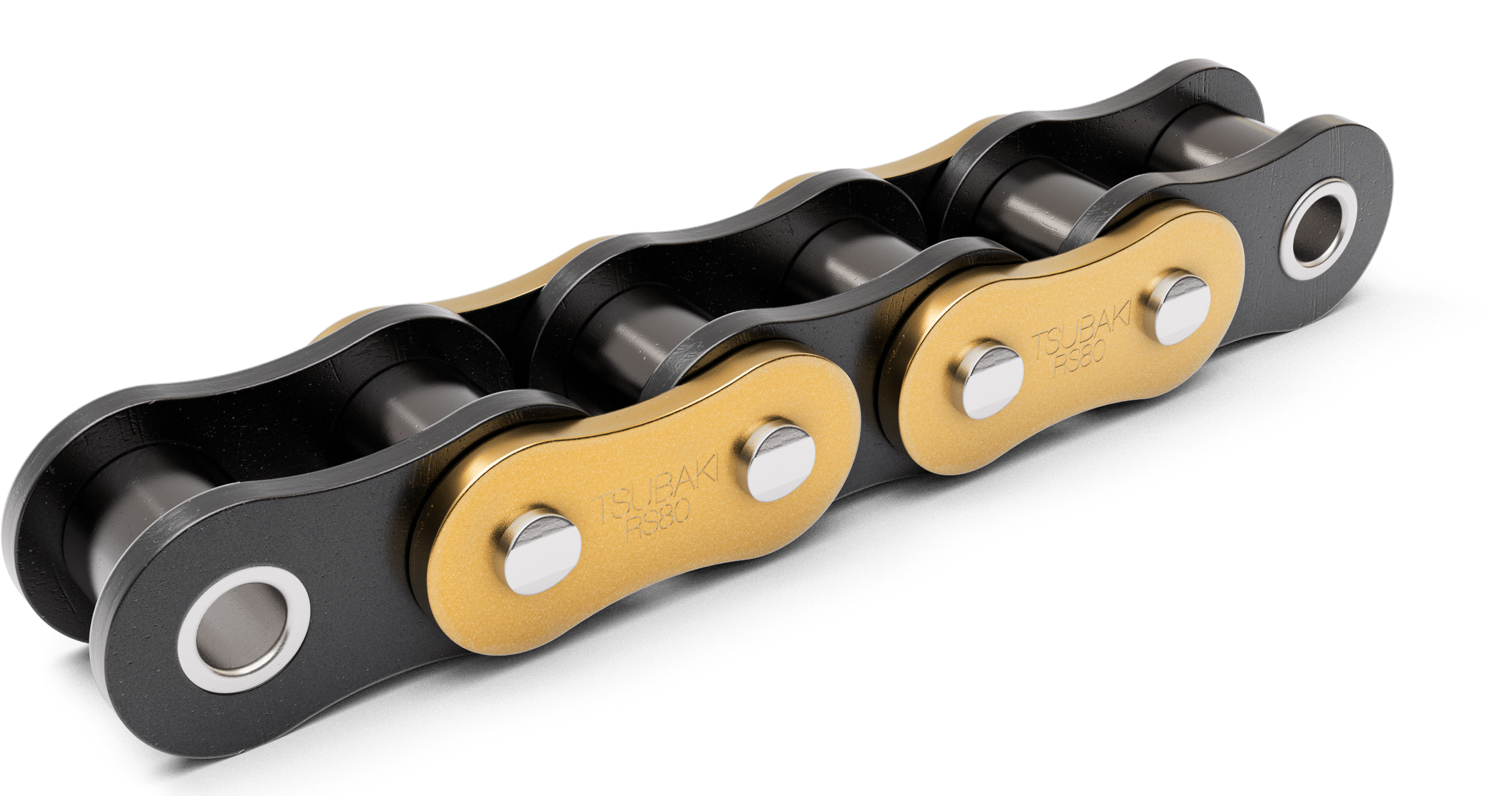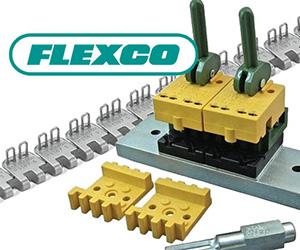Industrial roller chains keep our world moving. From conveyor systems to power transmission and lifting applications, these versatile workhorses come in a variety of shapes, sizes, and configurations. However, this wide variety means that there is a lot to know to ensure you get the right chain size for the job.
This comprehensive guide will equip you with the knowledge to measure roller chain pitch, along with other key dimensions such as chain inside width and roller diameter. Furthermore, the guide will demonstrate how to convert chain length from pitches to feet, which can be used effectively to purchase an appropriate chain for your next installation. Lastly, an extensive range of optimal roller chain options will be highlighted at the end of this article.
How to Measure a Roller Chain
If you know what chain size you have and would like to find out the key standard dimensions of your roller chain, you can refer to chain specification tables included in Tsubaki’s roller chain catalog. On the other hand, if there is no information on what chain is being employed, then the following steps will help you identify the chain size:
First, take a look at the side plates of roller chain and see if you can find the chain size stamped on any of the side plates. Some dirt or grease may need to be cleaned up. If a size marking cannot be found on any of the side plates, then the key chain dimensions will need to be measured and compared against catalog specifications.
One of the measuring tools that can be used to measure key chain dimensions is a caliper. A caliper can be utilized in measuring the roller chain pitch, chain inside width, and roller diameter. In most cases, the measured values of these three key dimensions can determine the chain size and which standard, ASME/ANSI (U.S.) Standard or ISO (Europe, referred to as “British Standard”) Standard, it is made to.

How to Measure the Chain Pitch
Chain pitch is a key dimension of a roller chain which should be measured and checked during the initial stage of identifying the chain. It is a constant that is specific to each roller chain size and is defined as a distance between the centers of adjacent pins. The pitch is often described as a fraction of an inch—⅜ inch, for example. Charts either use the fraction or convert it to a decimal number, e.g., 0.375 for ⅜ inch.
When trying to measure chain pitch, it may be challenging to point the jaw of the caliper at the center of each pin. In order to maintain effective accuracy, it is recommended to measure the chain pitch by zeroing out the digital caliper at the pin diameter distance and then measuring the outside-to-outside distance between two pins, as shown in the images below:


Mechanics often use the terminology “stretch” when checking the chain condition and planning a replacement of chain. In reality, it is a mechanical wear between pins and bushings which results in chain wear elongation. Typically, 1.5%-2% is considered to be the wear life limit for most industrial roller chain applications in order to assure effective equipment operation with predictable replacement intervals.
There are a variety of commonly used measuring tools, such as tape measures, that can help measuring chain length and determining chain wear condition. However, to help chain users to quickly measure and determine chain wear condition, Tsubaki offers premium Chain Wear Indicators. They are designed to easily determine if chain is close to “new”, “mid-point”, or “end” stage of its wear life. Learn more about Tsubaki’s Chain Wear Indicators now!


How to Measure the Chain Inside Width & Diameter
The rollers of roller chain engage with sprocket teeth that reflect roller dimensions. Please note that teeth are designed and cut at the exact distance that corresponds to chain pitch.
The chain inside width can be identified by utilizing the caliper’s upper (internal) jaws and measuring the distance between roller link (inside link) plates. On the other hand, the roller diameter can be identified by utilizing the caliper’s lower (external) jaws and measuring the outside diameter of the roller.
How to Measure the Plate Height & Thickness
A standard roller chain assembly consists of roller links (inside links) and pin links (outside links). Depending on its purpose and design, the side plates of a roller chain can be shaped as straight (“flat”) side plates or figure-8 (“hourglass”) side plates.
Use the lower (external) jaws of a caliper and measure the height of the side plates of roller link and pin link at their highest respective points. You can also use the same caliper jaws to measure the plate thickness. Note that the plate thicknesses between roller link and pin link can be different for certain types of roller chains.
Now that you have measured these roller chain component dimensions, you can identify the chain size with roller chain size charts in Tsubaki catalog.
Helpful Roller Chain Size Chart Terms
Roller chain size charts can be intimidating. There are a lot of terms to know! Here are some definitions that will prove useful when identifying what kind of roller chain you have:
- Chain Size: Roller chains are designed in accordance with either ASME/ANSI (U.S.) or ISO Standard (Europe). There is a correlation between chain size number and chain pitch, as follows with examples of single-pitch roller chains:
- ASME/ANSI: Divide the first digit (or the first two digits) of chain size number by 8 to define the chain pitch. For example, for #120 size, 12 divided by 8 equals 1.5 inch pitch.
- ISO: Divide the first digit (or the first two digits) of chain size number by 16 to define the chain pitch. For example, for #12B size, 12 divided by 16 equals 0.75 inch pitch.
- Chain Pitch (P): This is one of the key parameters and refers to the center-to-center distance between two adjacent chain pins. It corresponds to the size of the sprocket teeth the chain will engage with.
- Chain Inside Width (W): This refers to the inside width of the roller link (inside link) and is the distance between the two side plates of roller link.
- Roller Diameter (R): This is the diameter of the roller, which engages with sprocket teeth.
- Plate Height (H): This represents the height of the chain’s side plate and is measured at the highest respective points of pin link or roller link plates.
- Plate Thickness (T): This refers to the thickness of the side plate. Note that manufacturers offer an increased thickness of side plates (“Heavy Series”) for those heavier load applications.
- Multi-Strand Roller Chain: This refers to a roller chain with two or more chain rows assembled parallel to each other by longer pins as a full assembly. Hence, the chain capacity increases accordingly.
- Heavy-Duty Roller Chain: Heavy-duty roller chains typically have thicker side plates for the added load capacity, which allows them to withstand heavier loads and shocks.
- Double-Pitch Roller Chain: As the terminology indicates, the pitch of double-pitch roller chain is doubled while other key chain dimensions are mainly the same as single-pitch roller chain dimensions. Furthermore, double-pitch roller chains can be supplied with either straight side plates for conveyor applications or figure-8 side plates for power transmission applications.
- Double-Pitch Conveyor Chain: This type of double-pitch roller chain has straight (“flat”) side plates that allow for easy conveying applications with any product(s) positioned and carried directly on chain.
- Double-Pitch Transmission Chain: This type of double-pitch roller chain is less commonly used than double-pitch conveyor chains. Double-pitch transmission chain has figure-8 (“hourglass”) side plates and is primarily used for transmitting power between shafts. Note that the single-pitch roller chain is a more effective option for drive applications.
How to Convert Roller Chain Pitches to Feet
The formula that can be used to convert the number of chain pitches to feet is as follows:
# of pitches × chain pitch (in inches) / 12 = length (in feet)
For example, if there are 84 pitches in a #160 chain, multiply 84 pitches by 2 inches (pitch value of #160 chain) and then divide the number by 12 to convert the length into feet, which equals 14 feet.
Here is the ASME/ANSI chain size chart with chain pitch values in fractions and decimals:
|
ASME/ANSI CHAIN SIZE |
PITCH IN FRACTION (INCH) |
PITCH IN DECIMAL (INCH) |
|
25 |
1/4 |
0.250 |
|
35 |
3/8 |
0.375 |
|
40-41 |
1/2 |
0.500 |
|
50 |
5/8 |
0.625 |
|
60 |
3/4 |
0.750 |
|
80 |
1 |
1.000 |
|
100 |
1 1/4 |
1.250 |
|
120 |
1 1/2 |
1.500 |
|
140 |
1 3/4 |
1.750 |
|
160 |
2 |
2.000 |
|
180 |
2 1/4 |
2.250 |
|
200 |
2 1/2 |
2.500 |
|
240 |
3 |
3.000 |
Now, how does that work when you’re looking at a chart of chain sizes? For the ASME/ANSI sizes, the first digit (or the first two digits) of the chain size number tells you how many eighths of an inch the pitch is. If you have an ANSI 80 chain, that means that its pitch would be 8/8 of an inch or one inch. For ANSI 240 chain, its pitch would be 24/8, or three inches.
If we have an ANSI 120 roller chain with 180 pitches in length, what is this length in feet? We know that the pitch of ANSI 120 chain is 1.5 inches, so multiply that by 180 to get 270 inches and then divide 270 by 12 to get 22.5 feet. Please refer to the formula written above the table.
Let’s try this in reverse. If we need 8 feet of ANSI 40 chain, how many pitches does this chain need to have? With the ANSI chain size table above, we know the pitch of ANSI 40 chain is half an inch. To get 8 feet, multiply 8 times 12 to get 96 inches and divide 96 by 0.5 to get 192 pitches.
Knowing how to convert between pitches and feet makes it easy to confirm the chain length on an order and ensure that you are getting the exact roller chain length you need.
You’re now equipped to confidently measure the pitch and length of your roller chain, convert the length units, and know how to read roller chain sizing charts!
Which Roller Chain To Use?
Now that you know your chain size, it’s time to pick a replacement chain. Tsubaki offers the widest variety of roller chains in the market, serving a variety of industries.
They continue to enhance their standard ANSI and ISO chains and innovate many different specialty chains, such as Lambda®, Titan®, Neptune®, Super Stainless™, and many more. You can also count on precise manufacturing tolerances, which ensure smooth operation and reduced wear over time.
Lambda® chain is a lube-free roller chain that minimizes unnecessary maintenance and is ideal for applications where lubrication is not feasible or possible. It is available in single and double-strand drive chains.

Titan® chain is ready and available for your harsh environments. It is designed with specially coated pins to deliver the ultimate in strength and extended wear life for lumber, cement, high-speed applications, or other rough applications.

IBT Industrial Solutions’ Expert Power Transmission Division
A precise fit between your chain and sprocket is essential for optimal performance, durability, and safety. You also need to know how to lubricate your roller chain, as well as the proper roller chain installation methods. And “chain stretch“ is inevitable. If you have questions, we can help!
When it’s time for a replacement, reach out to us, and we can help you find the chain you need. We’ll ensure it has the correct specifications. We’ll also assist you in sorting through sizing, as well as any roller chain attachments or roller chain wear-resistant coatings.
We look forward to helping you select the perfect chain for your needs!







